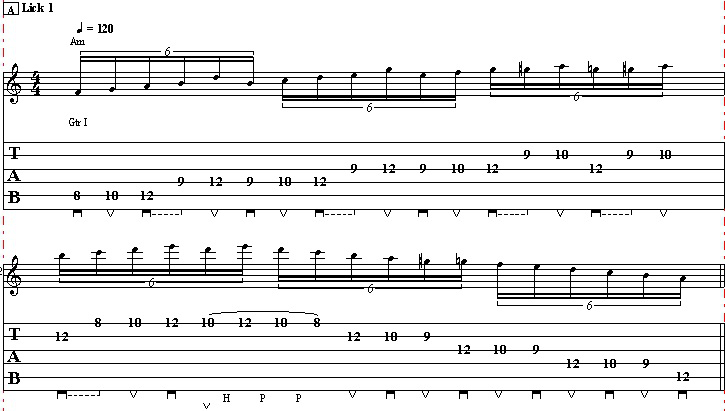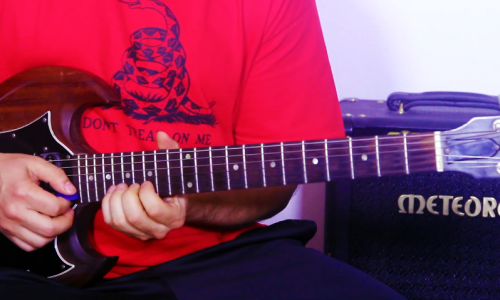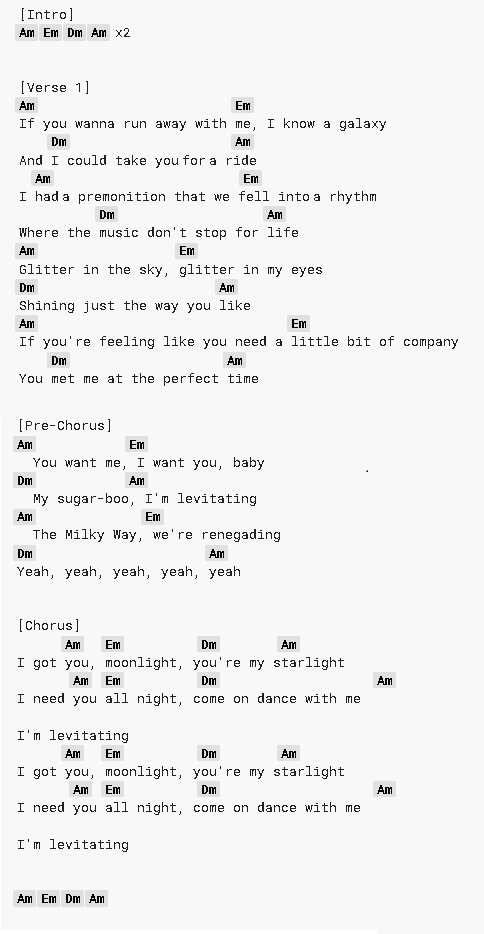
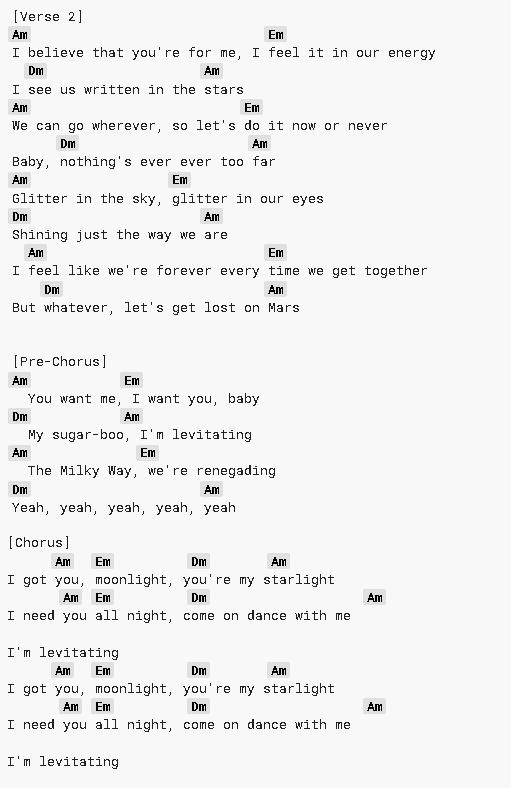
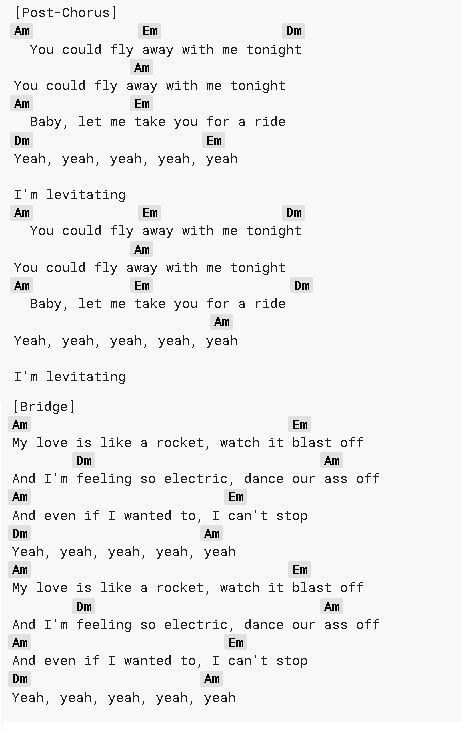
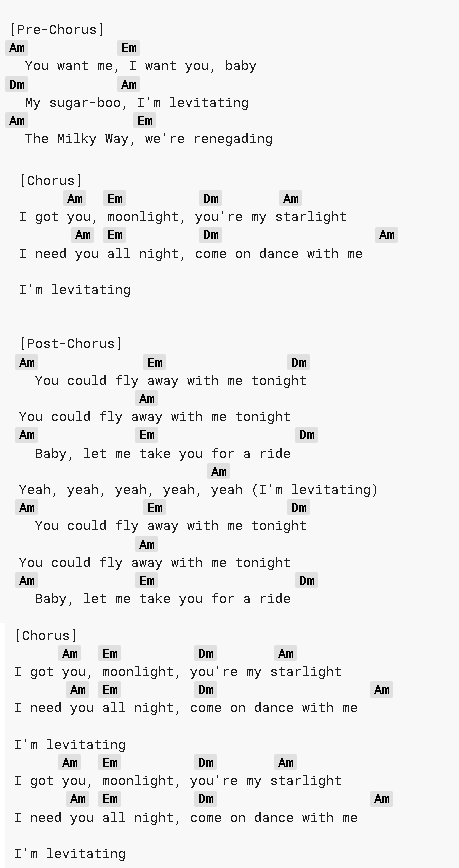
What’s going on everybody Sean Daniel here with Guitar Control, today we’re learning “Levitating” by Duo Lippa. A really cool pop song, easy to play and has great instrumentation.
Check the image above to follow the chords and tabs.
It’s only has three chords in four different spots but there’s a bunch of different ways you can play it, and a bunch of different ways you can make it groove. We’re going to do, is going to sound mostly like this! Okay so really easy.
Capo is on the second fret; okay you don’t need a capo to play this. We can talk about it later, but basically with the cable on the second fret the chords will be a minor, to e minor, to d minor, back to a minor. Again let’s start with the first chord a minor, pull your finger first fret on the b string ring finger second fret on the g string, middle finger second fret on the d string. The open a string is our root note of this chord.
The strumming is going to be this, let’s take those first two chords to kind of give that as an example because this one bars each. There’s the a minor to e minor. Okay e minor you just take that a minor chord move it one string lower and then take your pointer finger off. Now we just have two d and two a. Now the way I’m playing this, like that, is really not just going a minor e minor the rhythm of it I think is really important because again this is a bop
You got to make the song bop along with it. So we’re going to do get that down in your rhythm strumming hand right so on the one count we’re going to hit the root note of the chord, open a one, two and three, and four, and one, two, and three, four all right one two and now that two. I’m getting maybe the d and the g string –ish, and then strumming up on those same strings, just kind of aiming for d, g, and b, and just getting two, and one two, and one, two, and three, and four.
Now that three is going to be a little bit higher into the chord one, two, and three, and four, and now as soon as I hit that high part of the chord one, two, and three, right most of the chord there I’m kind of getting an open string set and then getting a 4 amp same thing open string set now by itself.
It doesn’t really sound good or bad it just sounds kind of neutral but it’s really a way to just make the chords sound different, as you transition into the following chord that e minor one, two, three, and four and, one, two, and three. Now we’re really going to kind of choke this one off because the second position one, two, and three, almost kind of like echoing a little bit.
What the bass guitar is doing in the original track that three, want to kind of get a percussive hit there one, two, and three. The one in that count of four is going to be the base. Now open e one, two, and three, four, one, two, and same deal, I’m kind of just running the middle of that chord one, two, and three, four. Notice I’m coming down hitting the cord, but I’m doing it with my palm and then kind of like letting go of the pressure, I’m not coming off the fret board, but I’m letting go of the pressure of my fretting hand to kind of really emphasize the attack that hit of that three count.
One, two, three, four, one, two, and three, see there’s kind of like space and having that space really kind of lends itself, well the next chord d minor pointer finger one on the high e string relative to the capo of course. I like to choose my pinky for a d minor you can use your ring finger if you want third fret on the b string and then middle finger second fret on the g string.
We’re getting there now, the last thing I want to talk about that e minor. Remember we left that space, sometimes I like to add a little bit of a mute, just to keep the beat going and one, two, three, and four, and one, two, and three, four, again we’ll do it super easy after this, but i wanted to talk about this d minor one, two, and three. I’m getting a pull off there because there’s a lot of action in the song even though the chords are simple the arrangement is always something going on, which is why it sounds like such a bop.
So on n the end of three, I’m just taking my finger my pointer finger off, that first fret and kind of playing it as I leave. One, two, three, and four same strong pattern one, two, three, and four, and one, and two and, three, and four. That brings us back to the a minor for the fourth spot in this group of four chords three different chords but there’s four spots.
So then the last one it’s kind of the same strumming as the e minor, but now we’re on a minor, hammer on my pointer finger into an a minor to give a little bit more action. I think since it’s the same chord progression that just repeats. Maybe every now and then you want to bring it way back one, two, three, four, one, two, three, four, one, two, three, four, one, two, three, four, they still kind of do that in the original version too, but then you can add that with the..
The nice thing about playing it kind of subdued like that we’re really keeping the rhythm, there’s always something going on, it’s very steady, you can use palm muting to kind of maybe make more of a dynamic, but the way I’m doing that is just keeping my palm on the bridge of the guitar.
It’s never sounding like that unless I wanted to that, would be the kind of high end of the energy of the song. Just let it all loose, the nice thing about that is the choruses are the same, as the verses, choruses have more energy by just really sustaining those same chords. Now the thing to remember is to really try to keep that count in mind because anytime you have a progression that starts on the same chord that it ends on. It’s really easy to get lost what I mean by that is like a minor, e minor, d minor, and then you’re in that a minor but you might be in the fourth bar of four on the a minor. That’s why we are doing an arrangement of this in this way. it really helps to kind of have a little bit of a variance in rhythm and that’s why we’re doing the arrangement of this in this way, where there’s a little bit of a difference the first, if we were to take these four chords and make them pairs like we started with a minor one, two, three, and four, and one, two, three, four, one, two, and three, and four, and one, two and, three, and four.
The counting is a little bit different one, two, and three, and four, and one, two, and three, four, one, two, and three, and four, and one, two, and three, four, having them be pairs is a great way to separate that a minor. Thinking of playing the a minor twice in a row you’re thinking of it being the first of four chords and the fourth of four chords and even though for all practical reasons there isn’t a difference it actually makes a big difference organizationally when you’re trying to keep it clean in the in the context of a song, again it’s a pretty easy song.
You can really just kind of make the whole thing, just vibe a little more with these little kind of Rhythmic Techniques, because again a minor e minor, d minor, a minor. You don’t need a capo to play the song, you can do the same thing open right, means you have to use you’re your pointer finger or whatever to bar chord it to make that a minor with the capo on the second fret, this b minor chord. So you can play the whole thing as a b minor, f sharp minor, and then a d minor, with k power 2 actually the same as e minor. The nice thing about that is you extend the range lower, whereas we had to play like an e minor with the capo on the second fret so you can play an e minor up here but really if you don’t have a cable you might as well use that open e minor position. That means b minor, to f sharp, e minor, to b minor. It’s up to you however you want to do it; the nice thing is if you know I’m playing this in like a set or something. Then I seamlessly take it in from something else, it doesn’t have a capo and then you can kind of just use these cords, it’s always good to be able to use a capo to make things easier on you but not use it as a crotch. So you can actually do it without a cable, I’ve been to shows too where it’s like crap I forgot my capo it’s actually happened once, it was really a very intense mental exercise to be able to play all the songs without a capo.
Thanks for checking it out if you have any questions or comments or other songs you want us to teach leave it in the comments we’ll get back to you and then in the meantime check out other videos on the Guitar Control YouTube Channel by myself and other great instructors, we’ll talk to you soon thanks a lot.


